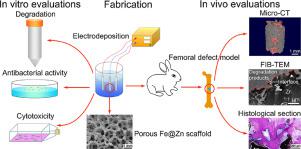Acta Biomaterialia ( IF 9.7 ) Pub Date : 2020-11-23 , DOI: 10.1016/j.actbio.2020.11.032 Jin He , Ju Fang , Pengbo Wei , Yulei Li , Hui Guo , Qingsong Mei , Fuzeng Ren

|
Three-dimensional (3D) porous zinc (Zn) with a moderate degradation rate is a promising candidate for biodegradable bone scaffolds. However, fabrication of such scaffolds with adequate mechanical properties remains a challenge. Moreover, the composition, crystallography and microstructure of the in vivo degradation products formed at or near the implant-bone interface are still not precisely known. Here, we have fabricated porous Fe@Zn scaffolds with skeletons consisting of an inner core layer of Fe and an outer shell layer of Zn using template-assisted electrodeposition technique, and systematically evaluated their porous structure, mechanical properties, degradation mechanism, antibacterial ability and in vitro and in vivo biocompatibility. In situ site-specific focused ion beam micromilling and transmission electron microscopy were used to identify the in vivo degradation products at the nanometer scale. The 3D porous Fe@Zn scaffolds show similar structure and comparable mechanical properties to human cancellous bone. The degradation rates can be adjusted by varying the layer thickness of Zn and Fe. The antibacterial rates reach over 95% against S. aureus and almost 100% against E. coli. A threshold of released Zn ion concentration (~ 0.3 mM) was found to determine the in vitro biocompatibility. Intense new bone formation and ingrowth were observed despite with a slight inflammatory response. The in vivo degradation products were identified to be equiaxed nanocrystalline zinc oxide with dispersed zinc carbonate. This study not only demonstrates the feasibility of porous Fe@Zn for biodegradable bone implants, but also provides significant insight into the degradation mechanism of porous Zn in physiological environment.
中文翻译:

具有核壳结构骨架的松质骨状多孔Fe @ Zn支架,用于可生物降解的骨植入物
具有中等降解速率的三维(3D)多孔锌(Zn)是可生物降解骨支架的有希望的候选者。然而,制造具有足够机械性能的支架仍然是一个挑战。而且,仍未确切知道在植入物-骨界面处或附近形成的体内降解产物的组成,晶体学和微观结构。在这里,我们采用模板辅助电沉积技术制备了具有骨架的骨架,该骨架由Fe的内芯层和Zn的外壳层组成,并对其骨架结构,力学性能,降解机理,抗菌能力和结构进行了评价。体外和体内生物相容性。原位定点聚焦离子束显微铣削和透射电子显微镜用于鉴定纳米级的体内降解产物。3D多孔Fe @ Zn支架显示出与人松质骨相似的结构和相当的机械性能。可以通过改变Zn和Fe的层厚度来调节降解速率。对金黄色葡萄球菌的抗菌率超过95%,对大肠杆菌的抗菌率几乎达到100%。发现释放的锌离子浓度的阈值(〜0.3 mM)可确定体外生物相容性。尽管有轻微的炎症反应,但仍观察到强烈的新骨形成和向内生长。在体内降解产物被鉴定为具有分散的碳酸锌的等轴纳米晶氧化锌。这项研究不仅证明了多孔Fe @ Zn用于可生物降解的骨植入物的可行性,而且为深入了解多孔Zn在生理环境中的降解机理提供了重要的见识。

























 京公网安备 11010802027423号
京公网安备 11010802027423号